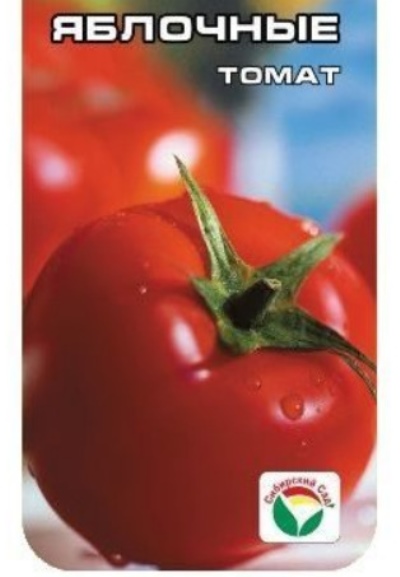
- Authors: Altai selection
- Category: grade
- Appointment: fresh consumption, for pickling and preserving
- Ripening period: mid-early
- Growing conditions: for open ground, for film greenhouses
- Bush size: medium-sized
- Bush height, cm: up to 100
- Bush characteristic: beautiful
- Ripe fruit color: Red
- Fruit weight, g: 300
Apple tomatoes are a development of Altai selection. The originator is unknown, the variety is not included in the State Register, sometimes the variety is called the result of amateur selection. This is a hardy, productive tomato, with huge fruits, apples, which can be considered not only by residents of the Urals and Siberia, but also from other regions.
Description of the variety
A bush of medium height up to 100 m, depending on the formation and method of cultivation, beautiful shape, compact width. Bushes of medium vigor and vigor.
The main qualities of the fruit
Fruits are large, juicy red, weighing 300 g each. The form is impeccable, marketable, slightly elongated vertically, the fruits, indeed, look like large apples. Shiny skin. There are small ribs. The peduncle is neat, holds well and is detached if necessary. The core is multi-chambered, with thick fleshy walls, dense. Fruits are collected in clusters up to 5 pcs.
Taste characteristics
The taste is great, sweet and refined, occasionally sourness can be felt, but quite light. The taste is difficult to describe, the epithets "original", "peculiar", "not like everyone else's" are best suited. Watermelon pulp, melting, excellent consistency, very pleasant fresh. The variety is universal, suitable for consumption on its own, as a dessert, or for preparing a variety of dishes: snacks, salads, juices. Suitable for processing: sliced winter salads, ketchups, sauces, pastas, lecho, adjika.
Ripening and fruiting
The variety is medium early, ripening up to 110 days, ripe fruits are removed from mid-August to September.
Yield
The yield is quite good, 3.5 kg of tomatoes are obtained from 1 adult bush.
The timing of planting seedlings and planting in the ground
They are planted for seedlings in mid to late March, seedlings are planted in open ground in the first week of June.

Growing tomato seedlings is an extremely important process, because it largely depends on whether the gardener will be able to harvest at all. All aspects must be taken into account, from seedbed preparation to planting in the ground.
Landing scheme
For 1 sq. m 2-3 plants are planted.

Growing and care
The variety can be grown in greenhouses and outdoors. The Volga region and Western Siberia have the most areas with excessively saline soil. Apple tomato is one of the few crops that grows well in saline areas.The variety has exactly that bush habit and type of fruiting that is best suited for difficult soils and harsh continental climates with its short, hot-dry summers and the likelihood of very cold nights in August. The fruits are large, but not late, the plant is hardy and stable.
Garter and shaping are required. They are formed into 1-2 stems, the stepsons must be removed, breaking them off with a sharp movement to the side. It is advisable to tie up not only the main stem, but also the brushes - they are very heavy. If there is a desire to get huge fruits, up to 500 g, the brushes are thinned, if smaller tomatoes are needed, 100-200 g each, but more numerous, all the ovaries are left.
Like all large-fruited tomatoes, Apple tomatoes love abundant watering and feeding. Watered with warm water, at the root, abundantly, but not too often. Otherwise, the fruit will become more watery and less sweet.
For taste, dressings are made with phosphorus, potassium, calcium. According to some reviews, the plant suffers from top rot, against which spraying will be useful:
calcium nitrate - 7-10 grams per 10 liters of water;
boric acid - 10 g per 10 liters of water;
"Brexil Ca" (the drug contains both calcium and boron);
infusion of wood ash - 1 glass of high-quality ash is poured into 1 liter of boiling water, infused for 1 day, filtered and diluted with cold water, bringing the volume to 10 liters;
soda solution - 20 g per 10 liters of water;
"Fitosporin" - 5 g per 10 liters of water.
And also the uniformity of watering will help prevent the disease. Drought impairs the absorption of calcium from the soil by tomatoes. On sandy soils, especially if summers can be hot, soil mulching is highly desirable. A small layer of peat will even out the sensations of soil moisture for plants, they will avoid the stress associated with possible drying out of the soil.
Deacidification of the soil also contributes to getting rid of the disease, which are slightly acidic tomatoes, but not strongly acidic. Dolomite flour is added to acidic soils before planting tomatoes, 400-500 g per 1 sq. meter.




A plant needs different micronutrients at each stage of growth. All fertilizers can be divided into two groups: mineral and organic. Folk remedies are often used: iodine, yeast, bird droppings, eggshells.
It is important to observe the rate and period of feeding. This also applies to folk remedies and organic fertilizers.


Review overview
The variety is so rare that its seeds are difficult to find commercially. Even fewer live reviews. Pros of the variety: magnificently beautiful even fruits, gigantic size that can be varied, sweet pulp. The fruits are not sour, not watery, firm, but not plastic. Of the minuses: low yield for a modern variety, but he is forgiven for the taste. The main difficulty with the variety is to get the "those" seeds. It is also worth remembering that the flavor of a tomato can be highly dependent on growing conditions.

























































































